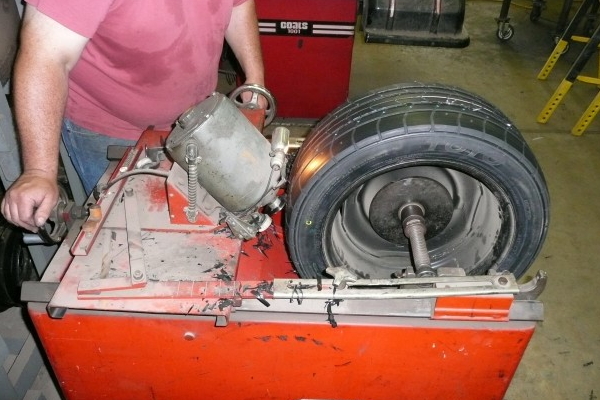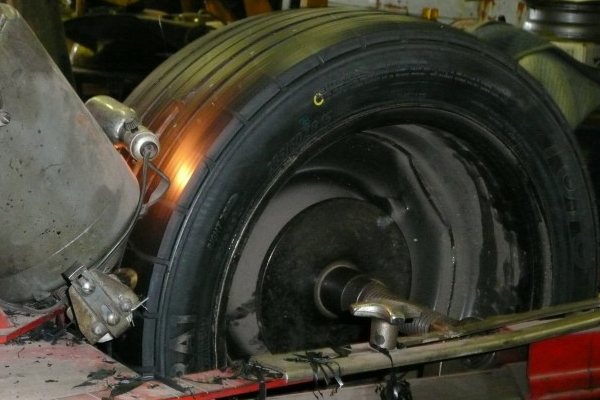How to shave tires? Tire what? Yes, tire shaving. We’ll forgive you if you’re not familiar with it, as this art has understandably become less popular and less necessary in the time since the radial tire overtook the market in the ’60s and ’70s. Before then, tire manufacturing was not very accurate and new tires actually came with extra tread—they were so far out of round, you’d need to have your installer shave tread off to make them circular or “true.” And so, shortly after the radial tire’s popularity brought with it advances in tire manufacturing, those tire shaving machines and the guys that ran them began to fade away.
But shaving at home still has its uses. Say you have an all-wheel-drive car that started with a full set of fresh rubber ten thousand miles or so ago and suddenly you find yourself needing a new tire as a result of a failure. A mismatched set of tires could force a modern four- or all-wheel-drive system to be constantly working to manage torque, causing undue stress and wear on the components. In order to prevent that type of problem, you could replace all four tires, or replace just the one and have it shaved down to the diameter of the three worn treads. Obviously, the second option would save you a lot of money.

tire shaving
Then there are those of us, myself included, who take a set of brand-new tires and lop off the top layer of tread in the name of grip. On a race track, increased grip means increased speed, so this sacrifice to the rubber gods is well worth it. While the tread on a street tire serves as a channel to route water away and avoid hydroplaning, it doesn’t do cars on a dry autocross course, circle track, or road circuit any favors.
A slick tire provides the most surface area for grip on dry pavement and that’s why you see race cars running smooth or slick tires. In the Spec Miata series, for example, racers are required to run the Toyo Proxes RA1 which is a full-tread, street-legal radial made with R-compound rubber. It provides excellent grip on both dry and wet tracks, but will yield even more traction when shaved down from full tread. As an added benefit, shaving also increases the on-track life of the tire by eliminating the chance of blistering, which can occur when a full-tread tire endures high track temperatures.
So that’s why I needed to find a tire shaver but, unfortunately, you’d be hard pressed to find more than a couple of guys in each state that can do the task. Here in Michigan, even near the Motor City, there is but one shop that I could find within a reasonable distance. Neal at Roger’s Cline Tire in Mason, Michigan, has been quietly shaving tires for about 30 years. To learn more about the process, I shadowed him as he prepped a set of rubber for my Spec Miata race car.

After mounting the tire on the machine
A new RA1 starts with a tread depth measuring 8/32 of an inch. I opted to have them shaved down to 4/32, which will just eliminate the lateral tread grooves. This is a common depth for budget racers although some with bigger bank rolls will go down to 3/32 or even 2/32 to get even stickier, at the cost of longevity.


So what do you do with your tire shavings? I’d like to get my hands on some for making things, but live in an area where tire shaving doesn’t happen much. Any chance I could buy some from you?
Interesting. Not sure I would want to do this on the kinds of tires I run, especially since they are always on the road with just daily driving, but I will say it is a constant concern with Quattro to have the tires in an even state all around. I had to replace one tire a couple of months after buying the car, but fortunately I was at less than 5k and it was okay to do it then.
They are so worn now at 40k they would ALL have to be replaced if something happened to one. The owner’s manual states very clearly not to run unevenly worn or mismatched tires with AWD. Even my private mechanic who is given to be experimental and doubtful of what automakers sometimes recommend confirms this with tires and AWD.
Tire shaving would work well for AWD vehicles when one tire is damaged and the dealer says you have to replace the other three because of thread depth. It could save you close to $900.
Well, tell Cadaliac that. They insisted all tires had to be replaced. The old tires had 13,000 miles. Who do you think you are that you can tell me what the situation was? Are you a Cadiliac offical? If so, get me back my $900.
I complained to Cadillac and they contacted the dealer and of course Cadillac said the dealer was correct. They claim because it’s AWD the tolerance is 2/32 on the wheels and mine had 4/32. Sounds like nit picking to me, but the insinuation was that it would affect the warranty on the drive train. At least my 99 Escalade has select drive and not AWD.
A cheaper way of doing this, and wasting less rubber, is to get a standard wood file and rough up the surface on new tires… This decreases the risks Philly mentioned, means you wast less tire, and improves grip
Can you use this method to get rid of flat spots?